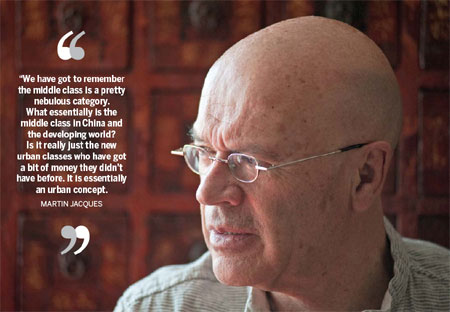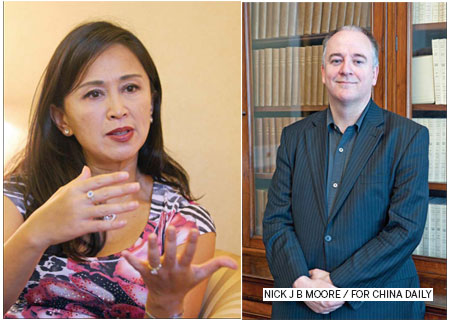Bulging middle
Updated: 2013-02-08 09:05
By Andrew Moody and Lv Chang (China Daily)
|
|||||||||||


|
From left: Helen H. Wang, author of The Chinese Dream: The rise of the World's Largest Middle Class and What It Means to You; and Kerry Brown, director of the China Studies Centre at Sydney University. Liu Zhe / China Daily |
China's emerging middle class is not just important to its own economy but is also a global phenomenon
Chinese consumption, largely driven by the middle classes, will account for $6.2 trillion (4.6 trillion euros), just under a quarter, of the $26 trillion of additional global consumption in the 15 years up to 2025, according to McKinsey & Co.
This is more than the three next BRIC countries combined with India contributing an extra $2.5 trillion, Brazil $1.4 trillion and Russia $770 billion.
Karl Gerth, author of As China Goes, So Goes The World: How Chinese Consumers are Transforming Everything and lecturer in Modern Chinese History at Oxford University, says every company in the world now has to have a strategy for the Chinese middle class.
"They certainly better have or if not, have an incredibly good justification for their shareholders," he says.
But who is this middle class that is so significant to the world and also in transforming China from an export and investment-led economy to a consumption one?
Is it different in its makeup to that in Europe or the United States, where there are also markedly different interpretations of the term either side of the Atlantic.
And also what makes them tick, what are their desires and aspirations and how do these differ from those in other countries?
In this issue, we look at the middle class attitudes toward and demand for healthcare, education, overseas travel, cars and home improvement products as well as fine dining, movies, luxury goods, financial services and online shopping.
Yuval Atsmon, principal in McKinsey & Co's Shanghai office and a core member of the leadership of the Greater China Consumer Retail Practice as well as co-author of the 2012 Annual Chinese Consumer Report, says the big trend over the next decade is that there is going to be a huge increase in the number of people in China of Western-style middle class incomes.
The proportion of people in China earning between $17,000 and $35,000 a year is set to increase from just 6 percent in 2010 to 51 percent in 2020.
"When we talk about people entering the middle class, we normally define this as around $10,000 a year when people start having the opportunity to make discretionary spending choices instead of worrying about the basics such as food, clothing and housing," he says.
"The higher income bracket more accurately reflects what we really mean about being middle class."
Helen H. Wang has made a name for herself writing about the Chinese middle class and, in particular, with her book The Chinese Dream: The Rise of the World's Largest Middle Class and What It Means to You.
Originally from Hangzhou in Zhejiang province, the California-based consultant defines the middle class in her home country as anyone who earns between $10,000 and $60,000.
"While the average income of the Chinese middle class may be lower than those in the Western countries, the cost of living in China is also lower," she says.
"In addition, many Chinese households have gray incomes that are not reported in the official data. So, the Chinese middle class should not be measured by international standards of income."
She says it is also misleading to regard car ownership as a badge of achieving Western-style middle class status.
"It is a myth. Many middle class people in the West do not own cars and cannot afford foreign vacations. Some choose not to," she says.
"My sister-in-law is a professor in Boston. She doesn't have a car. She prefers to use the public transit system and save money on parking and maintenance."
Gerth at Oxford University says what it means to be middle class in China has radically altered in recent decades.
"I have been going to China for 26 years and then if you had a nice pair of blue jeans and a bicycle, it made you middle class and comfortable. I don't think that passes anymore. No Flying Pigeon (famous Chinese bicycle brand) is going to get you a date," he says.
The academic says the current China class system may appear to be more like that of the US where it is often defined on income and not other social factors but he thinks that this is likely to be just a "temporary blip" relating to its stage of development.
"I live in England where class is something of an obsession but the longer I live here I begin to think that it is more similar to China and that it is America that is an exception," he says.
"I think factors such as which foreign school or university your children went to will begin to matter more in China and the class system will begin to ossify like in Europe."
Some see the queues outside Apple stores in major cities in China as being indicative of China's growing middle class.
A recent study by Boston Consulting Group indicates Chinese consumers were prepared to pay a 30 percent higher premium price for iPhones despite their incomes being much lower than that of US consumers.
John Ross, visiting professor at Antai College of Economics and Management of Shanghai Jiao Tong University and a former policy adviser to ex-London mayor Ken Livingstone, says this does not accurately reflect the realities of the market since Apple only has a 7.5 percent share of the China smartphone market.
"Even Samsung, which has been the market leader, is losing share. It is cheaper Chinese brand smartphones such as Lenovo, Coolpad and Huawei which are the big gainers," he says.
"This shows the extreme sensitivity of China's consumers to price," he says.
Ross says there are many difficulties in trying to assess whether people are middle class in China by the consumer choices they make.
"In the US or Europe, McDonald's or KFC, for example, would be considered very cheap and available even to those with very low incomes," he says.
"In China these are relatively higher priced, not bottom of the price range, items. This is why, for example, a KFC restaurant in China has far more 'eat in' tables than a KFC in the US or Europe."
Martin Jacques, author of When China Rules the World: The Rise of the Middle Kingdom and the End of the Western World, believes attempts to define the middle class in China can be hopelessly vague.
"We have got to remember the middle class is a pretty nebulous category. What essentially is the middle class in China and the developing world? Is it really just the new urban classes who have got a bit of money they didn't have before. It is essentially an urban concept."
Kerry Brown, director of the China Studies Centre at Sydney University, has just completed a book, provisionally titled Shanghai 2020, which will have a foreword by the incoming Shanghai mayor Yang Xiong, which examines the middle class in perhaps China's most middle class city.
"In Shanghai you have an authentic middle class because they regard themselves as stakeholders and they are quite demanding in terms of what service they expect from the government," he says.
"The middle class is fairly well networked and a great stabilizer of society. You certainly don't pick fights with the middle class in Shanghai."
Brown adds the middle class in China's second largest city can be loosely defined by the fact that they increasingly want greater control over their lives.
"They are also making choices. They don't have one child because of the one-child policy but for economic reasons so they can give that child a good education. They are also making choices about financial products such as life insurance and pensions."
Gerth at Oxford University says the Chinese middle class could be dismissed as just another nouveau riche phenomenon with people buying branded goods just to make statements about who they are.
"It probably is some sort of nouveau riche phenomenon but it is more of an intensified example of something familiar to us. It is not that it somehow hasn't happened anywhere else. Chinese people aren't Martians," he says.
Atsmon at McKinsey & Co says the significant difference between the new Chinese middle class and that of the US and Europe is they are entering this strata of society in a different era.
When Westerners became middle class, he argues, there were far few choices available.
"As consumers there are far more choices to make and being middle class is a much more complex thing than it was 80 to 100 years ago," he says.
Contact the writers at andrewmoody@chinadaily.com.cn and lvchang@chinadaily.com.cn
(China Daily 02/08/2013 page1)
Related Stories
Demystifying the middle-class myths 2013-02-08 09:36
Today's Top News
List of approved GM food clarified
ID checks for express deliveries in Guangdong
Govt to expand elderly care
University asks freshmen to sign suicide disclaimer
Tibet gears up for new climbing season
Media asked to promote Sino-Indian ties
Shots fired at Washington Navy Yard
Minimum growth rate set at 7%
Hot Topics
Lunar probe , China growth forecasts, Emission rules get tougher, China seen through 'colored lens', International board,
Editor's Picks

|

|

|

|

|

|






